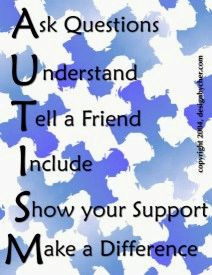The following is an article that I received via email. I feel it is a good outline of what
Is this Autism? Think of the person(s) you know on the autism spectrum. Do they have:
•
speech or language difficulties: no speech? delayed speech? echolalia?
•
sensory issues: over-sensitivity to sounds, lights, textures?
•
motor difficulties: fine motor? gross motor? motor planning?
•
emotional regulation difficulties: anxiety, depression, aggressive behavior?
•
physical or diet-related difficulties: allergies, limited diet?
•
repetitive behaviors: “stimming”, hand-flapping?
While “autism treatment” programs may target these areas of difficulties, all of the above are really co-occurring conditions, existing along with the autism. An individual could have all of the above, and not actually be on the autism spectrum at all.
So what is Autism? Again, think of the person(s) you know on the spectrum:
1)
Can they share experiences with you? For example, if they are non-verbal, can they share their emotional reactions to a mutual experience by smiling or laughing with you? If they are verbal, can they also share their feelings about what an event meant to them personally?
2)
Can they borrow your perspective? For example, if they don’t know how to handle something, can they look to you to help them resolve uncertain or ambiguous situations? Can they be soothed by just a reassuring look on your face? or notice if you are approving or disapproving?
3)
Can they “dance” with you? For example, can they do their part in coordinating with you when playing“peek-a-boo”? When walking side by side with you? Can they start or stop with you? If verbal, can they converse reciprocally?
4)
Can they reflect on past experiences & anticipate future experiences? For example, can they use an experience they had yesterday or last week, to avoid a negative result or repeat a positive one? Do they seem to understand consequences?
5)
Can they “go with the flow”? For example, if plans change, can they easily adapt to new conditions? Can they see things in shades of gray, rather than in black and white?
What autism researchers have found in the last five to ten years, is that it is a combination of these five core areas of difficulty above, which define Autism Spectrum Disorders: (1) Declarative, experience-sharing Communication, (2) Referencing, (3) Regulating, (4) Episodic Memory, and (5) Flexible Thinking.
Impaired Social & Emotional FunctioningIt is actually these areas of impaired social and emotional functioning which present the greatest obstacle to quality of life for people with autism spectrum disorders (ASDs). And the devastating impact that these impairments have throughout the lifespan has been well documented.*
Even when individuals with ASD do develop some social and emotional skills such as eye contact, emotion recognition, and turn-taking, these skills appear to be contained within a limited domain, characterized by encounters that are managed using scripted, predictable actions bereft of the emotional components of communication. Moreover, these encounters are driven primarily by the desire to use social and communicative behavior for instrumental purposes; that is, as a means to obtain specified goals.
Regardless of language abilities, IQ, academic success, or the presence of other co-occurring symptoms, individuals with Autism, Asperger’s Syndrome or Pervasive Developmental Disorder have difficulties in:
Declarative (Experience-sharing) Communication: If they are non-verbal, they may point to get what they want, and if they are verbal, they may ask questions, make demands or talk at length about their special interest, but verbally or non-verbally, they have an inability to share their experiences and feelings with you.
Referencing: They may learn to recognize and label various facial expressions, or be taught “eye contact,” but they can’t “borrow your perspective” to help them resolve situations of uncertainty.
Regulating: They may learn to follow procedures and scripts, but can’t “dance” with you, in back and forth interactions, if you are being spontaneous or unpredictable.
Episodic (autobiographical) memory: They may have good rote or procedural memory, but lack the kind of personal memory which allows them to reflect on past experiences or anticipate future ones.
Flexible Thinking: They may understand rule-based thinking, or use black-and-white thinking, but can’t rapidly adapt, change strategies or alter plans based on changing circumstances, think of multiple right answers, know when something is “good enough” or see “shades of gray.”
The
RDI® Program addresses all these core areas of difficulties identified by autism researchers* in a step-by-step, developmental way.
* For references, download the new Autism Spectrum Quarterly article by Dr. Steven Gutstein:
“Relationship Development Intervention–Developing a Treatment Program to Address the Unique Social and Emotional Deficits in Autism Spectrum Disorders."































































